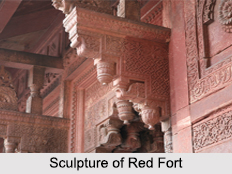 Sculpture of Red Fort is reminiscent of the great Mughal style of architecture which is located in the city of Delhi in India. It was built by the Mughal emperor Shah Jahan in the 17th century. Everything about the sculpture of Red Fort reflects the Mughal architectural tradition. Red Fort is one of the heritage buildings in India that has received recognition by the UNESCO as a World Heritage Site.
Sculpture of Red Fort is reminiscent of the great Mughal style of architecture which is located in the city of Delhi in India. It was built by the Mughal emperor Shah Jahan in the 17th century. Everything about the sculpture of Red Fort reflects the Mughal architectural tradition. Red Fort is one of the heritage buildings in India that has received recognition by the UNESCO as a World Heritage Site.
Features of the Sculpture of Red Fort
The features of Mughal sculpture are embedded in every nook and corner of Red Fort. A lot of ornamental work is the part of this Mughal monument. It was the tradition of the later Mughal architecture, an amalgamated style of Persian and native Indian art is reflected in the Red Fort. This style is known as the "Indo Islamic architecture". A range of calligraphy and inscriptions were part of the features of Indo Islamic sculptures.
The fort is octagonal, with the north-south alignment longer than the east-west axis. The marble, floral decorations and double domes in the fort`s buildings demonstrate the later Mughal architecture. The fort`s artwork produces Persian, European and Indian art, resulting in a distinctive Shahjahan approach rich in form, appearance and colour. The Lahori Gate is the chief doorway, leading to a domed shopping area known as the "Chatta Chowk" (covered bazaar). The two southernmost pavilions of the palace are "zenanas" (women`s quarters), consisting of the "Mumtaz Mahal" and the larger "Rang Mahal". The Mumtaz Mahal houses the Red Fort Archaeological Museum. The architecture and sculpture of gates to Red Fort are notable for their rich form and designs. The most important gates are the "Lahori Gate" and "Delhi Gate". Besides these there are the Mori Gate, Ajmeri Gate, Turkman Gate and Kashmiri Gate.
Besides the gates of the Red Fort, visitors will also come across the majestic architecture of "Diwan-i-Am", "Rang-Mahal", "Mumtaz-Mahal" , "Diwan-i-Khas", "Naqqar-Khana", "Khas Mahal", "Muthamman- Burj", "Tasbih-Khana", "Hammam", "Moti Masjid" and the sculpture of "Hayat-Bakhsh Garden" and Pavilions. The Lahori and Delhi Gates were used by the public, and the Khizrabad Gate was for the king.



















